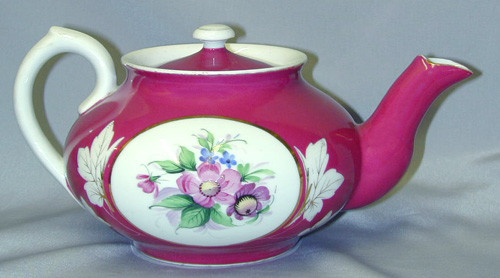Early History
Russian porcelain has an interesting history that dates back to the time of Peter the Great (1672-1725). Peter was fascinated with the beautiful Chinese porcelain that he had been presented to him and wanted to establish a viable porcelain manufactory in Russia. However, three hundred years ago the techniques and materials used to make fine porcelain were a well guarded secret, beyond the knowledge of anyone in Europe. Due to its rarity, porcelain was often called "white gold" and commanded a high price. The Chinese protected the secrets of porcelain manufacture so closely that magical qualities were ascribed to the material. Porcelain dishes were even believed to change color if poisoned food or drink was placed in them and this was one reason European monarchs, including Russia's Tsars, used Chinese porcelain at court. It was used to decorate the rooms of palaces and exchanged as presentation gifts among the rulers of Europe. Kings bartered their subjects for it and used it during ceremonial occasions. Noble ladies wore shards of porcelain as items of fine jewelry.
In Russia, Peter attempted to acquire the secrets to porcelain manufacture from various sources without success. A recipe, bought for an exorbitant sum from a master porcelain maker to the Emperor of China, proved useless.
After Peter's death his daughter, Empress Elizabeth (reign 1741-1761), continued to pursue her father's dream. In 1744, she selected Baron Cherkasov, the head of her Imperial Cabinet, to direct the establishment of a porcelain factory in St. Petersburg. Unfortunately, the first "expert" placed under contract was Christoph Hunger who proved to be arrogant and unskilled. He was fired in 1748 after producing only a few poorly formed cups and saucers that had little resemblance to porcelain.
Hunger was replaced by his apprentice, Dmitri Vinogradov, a well educated young man who had taken his tasks very seriously. During his apprenticeship, Vinogradov analyzed the raw materials, experimented to find the correct composition for porcelain paste, and kept detailed notes of his work. This scientific approach was key to the technical success finally achieved in 1751 when a small group of snuffboxes was produced.
Instead of receiving recognition and reward for his success, Vinogradov was constantly criticized by Cherkasov and was kept a virtual slave at the factory. Cherkasov issued an order to the factory that should Vinogradov "... not demonstrate sufficient vigilance out of his own sense of duty, he must be held under guard near the kiln for the entire time of firing, even if it entails his sleeping there." Later Vinogradov was put in chains and forced to finish his notebook describing, in detail, the techniques used to produce the porcelain. Heavy drinking and the harsh working conditions took their toll and Vinogradov died on August 15, 1758 at the age of 38.
Before his death, Vinogradov brought the quality of Russian porcelain to a level of equal to that of any porcelain produced in Europe at that time. After his death, the factory continued to work according the the rules and methods introduced by Vinogradov. Tea and coffee service, snuffboxes, buttons, Easter eggs, pipes, and other small items were produced to meet demand, but the original kilns were not suitable for anything larger. It was not until 1756, after a larger kiln was constructed, that the first Imperial table service was produced for Empress Elizabeth.
While only a few items from the Vinogradov have survived, his extensive notes on the technology of porcelain production provide the basis of manufacture at what is now the Lomonosov Porcelain Factory in St. Petersburg.

